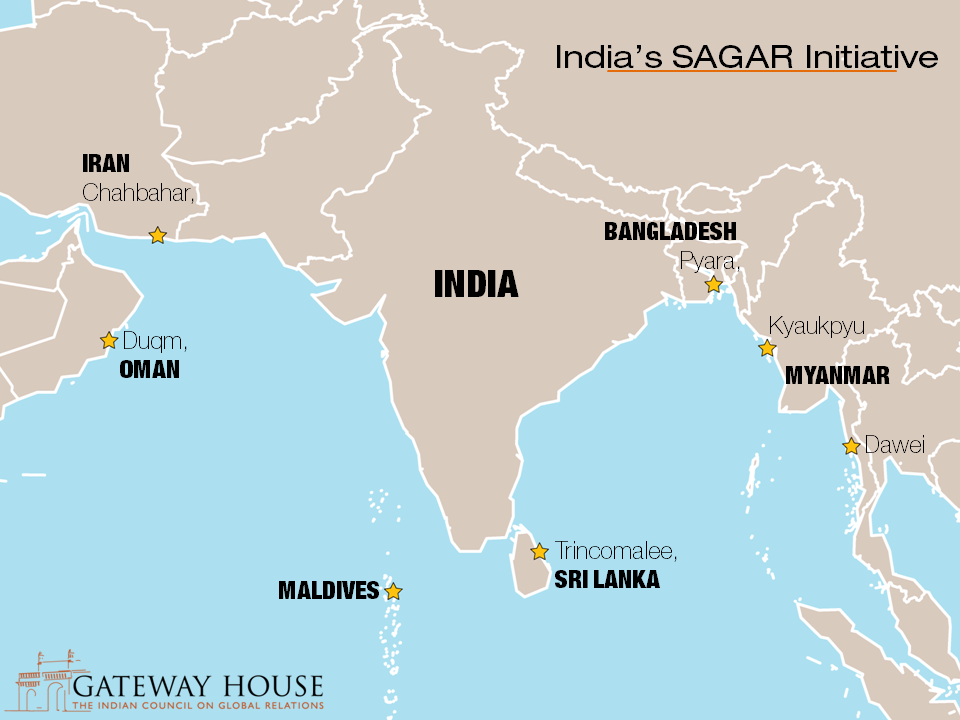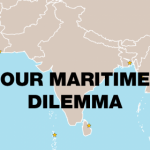The forthcoming and maiden Maritime India Summit in Mumbai on 14-16 April provides an appropriate backdrop to discuss a dilemma which will increasingly confront policymakers and money-managers in New Delhi. The answer to this will have an impact on India’s regional engagement in general, and in the development of its domestic infrastructure in particular. Nothing illustrates this better than the economic and diplomatic investments planned for project Sagarmala and the initiative of SAGAR (Security And Growth for All in the Region).
India’s creaking maritime infrastructure, especially its ports and cargo-handling capacity, needs urgent revitalization. This is being planned as Project Sagarmala, a necessary plan to modernise India’s ports which are vital to both trade and economic growth. It envisages massive infrastructure spending of Rs.70,000 crores to upgrade 12 major ports, and of over Rs.1 trillion for capacity-enhancement, modernisation and port-led industrial development.
There is also an urgent need to build bridges of friendship with our maritime neighbours for mutual benefit. This is encapsulated in, SAGAR, a worthy government initiative which recognises that a peaceful environment and calm seas are a prerequisite for trade to flourish.
As the putative regional power, India must establish both a climate of trust, and of economic intertwining between itself and its neighbours. This can be achieved by investing and assisting in the development of maritime infrastructure in the Indian Ocean Region (IOR), and specially in Bangladesh, Myanmar, Sri Lanka Maldives, Oman and Iran. SAGAR therefore becomes critical for national and regional security, given the presence of China which is already a serious investor in the countries in India’s proximate waters and primary areas of maritime interest.
Beijing’s partnering in port projects and facilities from Malacca to the Indian Ocean to the east coast of Africa – the “string of pearls” construct – is now folded into China’s extended vision of the Maritime Silk Route i.e. the oceanic part of the One Belt One Road (OBOR) initiative.
This is acknowledged as a strategic disadvantage to India. Some analysts recommend that India should welcome Chinese efforts, for India’s shipping and trade can also benefit from Beijing’s deep pockets which are building regional infrastructure. This path will surely undermine India’s long-term influence as both a strategic and economic player, let alone power, in the entire Indo-Pacific maritime region.
The most effective counter to the Chinese drive into the IOR will be for New Delhi to actively participate, and possibly even subsidise, the infrastructure projects in India’s strategic neighbourhood.
This means that SAGAR must be given preference over Sagarmala. Such a policy will do more for India’s lasting prosperity and growth than focusing purely on Indian ports, which are getting little attention domestically.

The six most important SAGAR initiatives are:
- The Bangladesh Pyara deepwater port project, despite reservations on silting, dredging and even financial viability issues. The port is near Chittagong, which China is helping to upgrade.
- The Kyaukpyu and Dawei ports in Myanmar. New Delhi can seize the advantage from the change of government in Myanmar to invest in projects solo or with allies like Japan, despite the Chinese head-start in the construction of the Kyaukpyu port in the Rakhine province, which can carry oil pipelines overland into China.
- Having lost Hambantota in Sri Lanka to Beijing, India should actively promote the petrochemical complex at Trincomalee, one of the best natural harbours in the world.
- In the Maldives, India must rebuild bilateral confidence, so it regains the privilege of being consulted in all strategic and maritime matters.
- The opportunity in Oman’s Duqm port on the Arabian Sea Coast, beyond the energy route’s choke-point of Hormuz. This may have been lost to Kuwait, which is now building infrastructure in Duqm, and where the UK’s Royal Navy will have a permanent presence. Indian companies can participate in the project through sub-contracts.
- Finally, there is the long-overdue Rs. 1.3 trillion promise to develop the Chahbahar port and its energy infrastructure – a project caught in the cross-hairs of inter-ministerial squabbles in New Delhi, and which China is also interested in. The upcoming visit of foreign minister Sushma Swaraj may resolve some of these problems.
None of this is possible unless New Delhi abandons its narrow accountant mindset which demands immediate book-balancing, and discounts intangible gains from government expenditure. The Marshall plan for the successful post-World War II reconstruction of Europe, and consequent U.S. strategic advantage in that continent, is the best example of strategic expenditure, the returns from which far exceeded any financial losses incurred by the U.S.
The time is nigh for India to be expansive in its approach to regional funding outlays. This will require a strategic decision – such as upgrading existing ports over building new ones under the Sagarmala plan because India’s trade has not expanded commensurately. Instead, better to prioritise and fund SAGAR, which will provide access to those strategic nations and be a balancing factor to China’s Indian Ocean play.
Vice Admiral Anil Chopra is Distinguished Fellow, Maritime Studies, Gateway House. He was the former Commander- in-Chief of the Western Naval Command, the Eastern Naval Command, and former Chief of the Indian Coast Guard.
This article was exclusively written for Gateway House: Indian Council on Global Relations. You can read more exclusive content here.
For interview requests with the author, or for permission to republish, please contact outreach@gatewayhouse.in.
© Copyright 2016 Gateway House: Indian Council on Global Relations. All rights reserved. Any unauthorized copying or reproduction is strictly prohibited.


